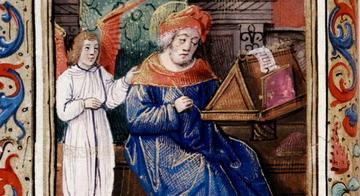Medieval manuscripts: how we are working from home
This is reblogged from The Conveyor, the News channel from the Bodleian Libraries Centre for the Study of the Book. Subscribe to it here for regular notifications about manuscripts, early printed books, the Bodleian press and more!
The Bodleian medieval manuscript specialists have been working from home. Watch this film, and read this online catalogue of medieval manuscripts to learn how it is being improved, even at a distance from the manuscripts themselves. Take a digital tour of the online resources available to everyone, starting with medieval manuscripts in digital.bodleian, and make a special trip with the Polonsky Foundation to see the Bodleian’s manuscripts from German-speaking lands in partnership with the Herzog August Bibliothek.
So, how does a curator of manuscripts work remotely?
Good question! To be honest, we’re still working it out. A normal day used to involve a lot of contact not just with manuscripts but with reference works, many of which aren’t online. Not having access to any of those is going to be challenging. But one thing we can do is work on enhancing the records in our online manuscript catalogue.
Doesn’t the online catalogue already cover all your medieval manuscripts?
It does! But almost all the records are only brief compact descriptions. These give a summary of the textual content and languages used, a broad categorization of the decoration, information on the writing support (usually paper or parchment), and the date and origin of the manuscript. But they often don’t cover all the textual content and generally don’t have any other physical description (e.g. information about bindings) or any information about the history of the manuscripts.
Why wasn’t that information included?
- Usability; Simply having all our catalogues rekeyed would have been of limited value, for several reasons. Many of them are in Latin, so not very user-friendly; and a lot of the information in the older catalogues needs interpretation and updating to be useful to today’s readers.
- Accuracy about provenance; The older catalogues were often mistaken about the date or origin of manuscripts. The Bodleian’s summary catalogue of illuminated manuscripts (“Paecht and Alexander”) is much more reliable, and we’ve updated older records with reference to that catalogue where possible.
- Accuracy about content; It’s usually possible to identify texts in the manuscripts more reliably and accurately. For example the 1922 description of MS. Bodl. 40 contains this snippet, ascribing one text to William of Ramsey:

By checking some online databases and chasing up our online bibliography for the manuscript we can see that this text is in fact by Henry of Avranches.
What does that all mean for the catalogue?
Rather than simply reproduce the information in the main printed catalogues, it was decided to create an updated summary of those catalogues that was more accurate in some ways, but less comprehensive in others. The original intention was that the online catalogue would be a way into the printed catalogues, rather than replacing them completely.
But once you provide an online catalogue, users expect it to contain everything.
Exactly; and enhancing the catalogue records is now a major focus of our work at the library. Fortunately it’s something we can continue to do remotely.
How can you catalogue without seeing the manuscripts?
Enhancing the catalogue records doesn’t only result from fresh cataloguing – although that does happen, of course. We also have an ongoing programme of retroconversion – putting all the contents of the printed catalogues online, and updating them as far as possible from key secondary resources, but usually without seeing the manuscripts themselves. This is a much quicker process than fresh cataloguing – it might take a week or more to newly catalogue a manuscript, but on average only an hour to retroconvert a printed record.
So what changes will I see in the catalogue?
Here’s a film to show in more detail how the records are being upgraded.
We’re currently working on records from volume 2 of the Bodleian’s Summary Catalogue (published 1922-1937), covering manuscripts acquired by the Library before 1697. All records will include more information about the owners of manuscripts and their acquisition; all will include a bit more physical description (number of folios, page size, and binding if early); and many will include much fuller information about the textual contents and languages found in manuscripts. MS. Bodl. 90 is an example. The original record looked like this:

You can see the revised record here. You can compare the differences for yourself: what stands out for me about this record is the enormous improvement in the accuracy and detail with which the manuscript’s textual content is covered. In other records there might be less new information about contents but more about early owners. In general, as work progresses, the online catalogue will give a much better idea of the texts that can be found in our manuscripts, and of where those manuscripts were in the Middle Ages.
For more medieval matters from Oxford, have a look at the website of the Oxford Medieval Studies TORCH Programme and the OMS blog.



